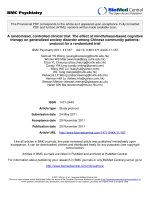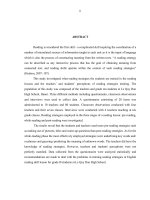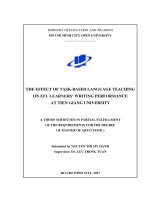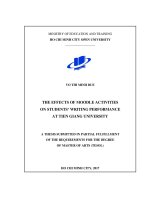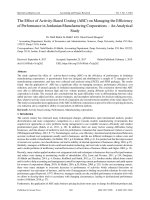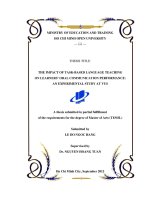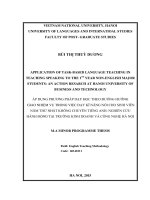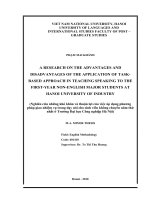the effect of task based language teaching on efl learners’ writing performance at tien giang university
Bạn đang xem bản rút gọn của tài liệu. Xem và tải ngay bản đầy đủ của tài liệu tại đây (1.38 MB, 161 trang )
MINISTRY OF EDUCATION AND TRAINING
HO CHI MINH CITY OPEN UNIVERSITY
----------------------------
THE EFFECT OF TASK-BASED LANGUAGE TEACHING
ON EFL LEARNERS’ WRITING PERFORMANCE
AT TIEN GIANG UNIVERSITY
A THESIS SUBMITTED IN PARTIAL FULFILLMENT
OF THE REQUIREMENTS FOR THE DEGREE
OF MASTER OF ARTS (TESOL)
Submitted by NGUYEN THI MY HANH
Supervisor: Dr. LUU TRONG TUAN
HO CHI MINH CITY, 2017
STATEMENT OF AUTHORSHIP
I certify that the thesis entitled “The effect of Task-Based Language Teaching on
EFL Learners’ Writing Performance” is my original work. All resources used in
the thesis have been documented. The work has not been submitted to Open
University or elsewhere.
Ho Chi Minh City, March 7th, 2017
Nguyen Thi My Hanh
i
ACKNOWLEDGEMENTS
I have secured a lot of assistance and advice from many people in order to complete
my thesis. I am very grateful for this help.
First of all, I would like to express my sincere thanks to my supervisor, Dr. Luu
Trong Tuan for his considerate assistance and invaluable advice. Without his help,
the study couldn’t have been completed.
Secondly, I want to express my deep gratitude to the Management of Tien Giang
University and the Leaders of Faculty of Social Sciences and Humanities for their
permission and support.
Finally, I would like to sincerely thank my colleagues for their support as well as
the students in two classes 0728201 and 0728202 for their cooperation.
ii
ABSTRACT
The present research is aimed at investigating the effect of Task-Based Language
Teaching (TBLT) on EFL learners’ writing performance and learner writing
motivation considered as a mediating variable in enhancing writing performance of
EFL learners at Tien Giang University. The quasi-experimental design was
employed with the participation of 40 freshmen (20 in CG and 20 in EG). The
analysis of the data collected from the participants’ pretests and posttests, prequestionnaires and post-questionnaires indicated that TBLT had a positive influence
on EFL learners’ writing performance and their writing motivation. EFL learners
made significant progress in all five components of a writing (vocabulary, content,
grammar, organization and mechanics) and two factors in learner writing motivation
(perceived value of writing and writing self-concept). In addition, there was a
positive correlation between learner writing motivation and writing performance.
Learner writing motivation contributed 37% to the improvement of writing
performance.
Key words: Task-based language teaching (TBLT), writing performance, learner
writing motivation.
iii
LIST OF ABBREVIATIONS
CG
Control Group
CLT
Communicative Language Teaching
EFL
English as Foreign Language
EG
Experimental Group
ESL
English as Second Language
L2
Second Language
SCT
Social-Cultural Theory
TBLT
Task-Based Language Teaching
TESOL
Teaching English to Speakers of Other Languages
ZPD
Zone of Proximal Development
iv
LIST OF TABLES
Table 2. Task types
10
Table 3.1 Characteristics of participants
39
Table 3.2 Writing topics for each week
40
Table 3.3 Items of pre-questionnaire on learner writing motivation
43
Table 3.4 Items of post-questionnaire on learner writing motivation
44
Table 3.5 Structures of pre-questionnaire and post-questionnaire of CG and EG
45
Table 3.6 Summary of traditional lesson plans for fifteen weeks
46
Table 3.7 Summary of TBLT lesson plans for fifteen weeks
50
Table 4.1 Correlation of two raters’ pretest scores of CG
65
Table 4.2 Correlation of two raters’ pretest scores of EG
65
Table 4.3 Descriptive statistics of the pretest scores
66
Table 4.4 Independent samples t-test results of the pretests
67
Table 4.5 Correlation of two raters’ posttest scores of CG
68
Table 4.6 Correlation of two raters’ posttest scores of EG
68
Table 4.7 Descriptive statistics of the posttest scores
69
Table 4.8 Independent samples t-test results of the posttests
69
Table 4.9 Descriptive statistics of the pretest scores and posttest scores
70
Table 4.10 Pair sample t-test results of the writing tests
72
Table 4.11 Descriptive statistics of each component of the writing tests
73
Table 4.12 Independent samples t-test results of each component of writing tests 74
Table 4.13 Descriptive statistics of each component before and after the treatment 75
Table 4.14 Pair sample t-test results of the components of writing tests
76
Table 4.15 Item-total statistics of the pre-questionnaire of CG
78
Table 4.16 Item-total statistics of the pre-questionnaire of EG
79
Table 4.17 Rotated components matrix of the pre-questionnaire of CG
80
Table 4.18 Rotated components matrix of the pre-questionnaire of EG
81
v
Table 4.19 Descriptive statistics of the pre-questionnaires of CG and EG
82
Table 4.20 Independent samples t-test of the pre-questionnaires
83
Table 4.21 Item-total statistics of the post-questionnaires of CG
84
Table 4.22 Item-total statistics of the post-questionnaires of EG
85
Table 4.23 Rotated component matrix of the post-questionnaire of CG
85
Table 4.24 Rotated component matrix of the post-questionnaires of EG
86
Table 4.25 Descriptive statistics of the post-questionnaires
87
Table 4.26 Independent samples t-test results of the post-questionnaires
88
Table 4.27 Descriptive statistics of the scores of the pre-questionnaires and
post-questionnaires
90
Table 4.28 Pair sample t-test results of the pre-questionnaires and postquestionnaires of learning writing motivation
Table 4.29 Descriptive statistics of the two factors of the questionnaires
90
91
Table 4.30 Independent samples t-test results of the each factor
of the questionnaires
92
Table 4.31 Descriptive statistics of the each factor of the questionnaires
93
Table 4.32 Pair sample t-test results of the each factor of the questionnaires
94
Table 4.33 Correlation between learner writing motivation
and writing performance in EG
96
Table 4.34 Regression between learner writing motivation
and writing performance
97
vi
LIST OF FIGURES
Figure 2.1 Task-Based Language Teaching Framework
16
Figure 2.2 Research model
34
Figure 4.1 Mean score of the pretests and the posttests
71
Figure 4.2 Mean score of the pre-questionnaire and post-questionnaires
89
vii
TABLE OF CONTENTS
STATEMENT OF AUTHORSHIP
i
ACKNOWLEDGEMENTS
ii
ABSTRACT
iii
LIST OF ABBREVIATIONS
iv
LIST OF TABLES
v
LIST OF FIGURES
vii
TABLE OF CONTENTS
viii
CHAPTER 1
INTRODUCTION
1
1.1 Statement of the problem
1
1.2 Purposes of the study
5
1.3 Research questions
5
1.4 Significance of the study
5
1.5 Organization of the study
6
CHAPTER 2
7
LITERATURE REVIEW
2.1 Concepts
7
2.1.1 Tasks
7
2.1.1.1 Definition of task
7
2.1.1.2 Task types
9
2.1.2 Task-Based Language Teaching
12
2.1.2.1 What is Task-Based Language Teaching
12
2.1.2.2. Underlying theories for Task-Based Language Teaching
13
2.1.2.3 Principles of Task-Based Language Teaching
15
2.1.2.4 Task-Based Language Teaching Framework
16
2.1.2.5 Benefits of Task-Based Language Teaching
19
2.1.3 Learner writing motivation
20
viii
2.1.3.1 What is learner motivation
20
2.1.3.2 Types of learner motivation
21
2.1.3.3 Learner motivation in writing
22
2.1.4 Writing performance
22
2.1.4.1 What is writing
22
2.1.4.2 Writing performance
23
2.2 Hypothesis development
24
2.2.1 Task-Based Language Teaching and writing performance
24
2.2.2 Task-Based Language Teaching and learner writing motivation
29
2.2.3 Learner writing motivation and writing performance
32
2.3 Chapter summary
35
CHAPTER 3
36
METHODOLOGY
3.1 Research setting
36
3.2 Research design
37
3.3 Data collection procedures
38
3.3.1 Participants
38
3.3.2 Materials
40
3.3.3 Instruments
41
3.3.3.1 Pretest and posttest of writing
41
3.3.3.2 Pre-questionnaire and post-questionnaire of learner writing motivation
42
3.3.4 Experimental procedures
45
3.3.4.1 Teaching procedures for control and experimental groups
45
3.3.4.2 Procedures of data collection
59
3.4 Data analysis approach
60
3.4.1 Normal distribution of the sample
60
3.4.2 Validity and reliability of instruments
60
3.4.2.1 Pretest and posttest
61
3.4.2.2 Questionnaire for learner writing motivation
61
3.4.3 T-test
62
ix
3.4.4 Correlation and regression analysis
62
3.4.4.1 Correlation analysis
62
3.4.4.2 Regression analysis
63
3.5 Chapter summary
63
CHAPTER 4
64
RESULTS
4.1 Research question 1: To what extent does TBLT influence EFL learners’
writing performance at Tien Giang University?
65
4.4.1 Before the treatment
65
4.1.2 After the treatment
67
4.2 Research question 2: To what extent does TBLT influence learner writing
motivation at Tien Giang University?
78
4.2.1 Before the treatment
78
4.2.2 After the treatment
83
4.3 Research question 3: To what extent does learner writing motivation
influence EFL learners’ writing performance at Tien Giang University?
95
4.3.1 Correlation between learner writing motivation and writing performance
95
4.3.2 Regression between learner writing motivation and writing performance
96
4.4 Chapter summary
97
CHAPTER 5
98
DISCUSSIONS
5.1 Research question 1: To what extent does TBLT influence EFL learners’
writing performance at Tien Giang University?
98
5.2 Research question 2: To what extent does TBLT infuence learner writing
motivation at Tien Giang University?
100
5.3 Research question 3: To what extent does learner writing motivation
influence EFL learners’ writing performance at Tien Giang University?
5.4 Chapter summary
CHAPTER 6
102
102
CONCLUSIONS, LIMITATIONS AND
RECOMMENDATIONS
6.1 Conclusions
104
104
x
6.2 Implications
106
6.2.1 For teachers
106
6.2.2 For students
106
6.3 Limitations
107
6.4 Recommendation
108
REFERENCES
109
APPENDICES
122
Appendix A: Pretest
122
Appendix B: Posttest
123
Appendix C: Marking Scale
124
Appendix D: Pre-questionnaire of learner writing motivation for CG and EG
128
Appendix E: Pre-questionnaire of learner writing motivation for CG and EG
(Vietnamese version)
129
Appendix F: Post-questionnaire of learner writing motivation for CG
131
Appendix G: Post-questionnaire of learner writing motivation for CG
(Vietnamese version)
132
Appendix H: Post-questionnaire of learner writing motivation for EG
134
Appendix I: Post-questionnaire of learner writing motivation for EG
(Vietnamese version)
135
Appendix J: A sample traditional lesson plan
137
Appendix K: A sample TBLT lesson plan
139
Appendix L: Samples of the students’ paragraphs
143
xi
CHAPTER 1
INTRODUCTION
There are five sections in chapter 1. The first section is statement of the problem.
The second section mentions three purposes of the study. Based on the three
purposes, three research questions are presented in the third section. Significance of
the study is mentioned in the fourth section. The last section is organization of the
study which consists of six chapters namely introduction, literature review,
methodology, results, discussions and conclusions, implications, limitations and
recommendations for further research.
1.1 Statement of the problem
For English language learners, writing is a very important skill (Al-Shourafa, 2012).
Wolff (2000) states that “writing is not only a means of communicating, but also a
tool of learning a language” (p. 111). According to Mohamed (2003), writing helps
non-English native students to learn because it enhances the grammar, structure
idioms and vocabulary, gives them chances to experience the language, to go
beyond what they have just to say and to take risks and become involved with the
new language. Abdali and Fatemipour (2014) indicate that “EFL learners should
write reports, thesis, essays, and compositions so as to meet the demands of their
authorities” (p. 730). In addition, writing is necessary for students’ learning, career
and their daily communication (Al-Shourafa, 2012).
In spite of its important roles, it is difficult to acquire this skill (Tribble, 1997).
Zhaochun (2015) argues that writing is the most difficult skill to master. According
to Byrne (1979), writing is the transformation of thoughts into language. This
means that writing requires writers’ both mental and physical activities to
1
communicate with readers or enable them to understand writers’ feeling and
thought. Unlike speaking skill, there is no feedback between writers and readers in
writing skill, which makes writing skill more difficult than speaking skill.
According to Al-Shourafa (2012), it requires L2 writers “to use a second language
writing system and simultaneously perform a range of complex cognitive tasks such
as making a decision on content relevant to a topic, selecting proper vocabulary and
grammar to form sentences, organizing sentences into a paragraph and consider the
writing purpose and intended audience” (pp. 1-2). Furthermore, learning a foreign
language in the context where learners’ exposure to language is just for few hours
each week makes writing become a demanding activity (Kim & Kim, 2005).
Because writing is a very difficult skill to master, learners need to be provided a lot
of opportunities to improve their writing skills. However, Trinh and Nguyen (2014)
stated that “in most academic writing classes in the Mekong Delta, the teacher
provides learners with a topic and a related model text. The teacher picks out
sentences from the model texts for learners to study grammatical structures; how
and what to write are seldom discussed. The communicative purpose and audience
of the texts seem to be ignored. The teacher does not focus much on the content of
the model texts, but focuses more on form.” (p. 64). Teaching writing in such a way
does not give learners many opportunities to interact with one another and express
their ideas. Willis (1996a) emphasizes that through meaning-focused activity,
interaction and a removal of teacher dominance, tasks can help enhance fluency and
natural acquisition. Moreover, teachers dominate the class and learners become
passive in their study. Teacher-dominated class is boring and it kills the students’
interests (Kundo & Tutto, 1989). Similarly, at Tien Giang University, teaching
writing has also focused on form rather than meaning. Students have to spend most
of the time doing grammatical exercises rather than interacting and negotiating with
one another. In reality, the average score of writing tests of EFL students at Tien
Giang University in the academic year 2014-2015 was quite low, at 6.1 (Center of
2
educational testing and quality assessment of Tien Giang University). In addition,
English writing teachers said that in general EFL students at Tien Giang University
were not interested in their writing class. This indicates that it is very necessary to
have an effective method for teaching writing to enhance EFL learners’ writing
performance and to improve their writing motivation which contributes to EFL
learners’ writing performance.
Many methods for teaching writing have been introduced to foster learners’ writing
skills. Among them is Process Approach which focuses on “the steps involved in
drafting and redrafting a piece of work” (Nunan, 2001, p. 272). Nevertheless, this
approach has some limitations. First, it ignores the accuracy in favor of fluency
(Reid, 2001). Paying less attention to grammar and structure negatively affects the
quality of writing. Furthermore, Process Approach emphasizes the process of
producing a writing product regardless of the time it takes (Sadeghi, Hassani &
Hemmati, 2013). With the emphasis on the relationship between text-genres and
their contexts, Genre-based Approach has also been proposed as an approach in
teaching writing (Hyon, 1996). Nevertheless, Badger and White (2000) argue that
“the negative side of genre approaches is that they undervalue the skills needed to
produce a text and see learners as largely passive” (p. 157). Moreover, Bawarshi
(2000) indicates that while the strength of genre-based approach is that it helps
learners to identify and interpret literary texts, its weakness is that it interferes with
the learners’ creativity.
In the process of searching for a better way to promote learners’ writing
performance, a number of researchers have also indicated that it is beneficial to
apply Task-Based Language Teaching (TBLT) which is based on communicative
and interactive tasks, requiring meaningful communication and interaction among
learners (Bygate, Skehan, & Swain, 2001; Nunan, 2004b). It is a logical
development of Communicative Language Teaching (CLT) (Richards and Rodgers,
3
2001). TBLT focuses not only on communicating through interaction in the target
language, but also on grammatical accuracy and forms (Nunan, 2004a). As viewed
by Zhaochun (2015), this approach “takes into account the writing process and the
final products as well” (p. 72). According to Ellis (2003), it is in harmony with a
learner-centered educational philosophy. Moreover, Lee (2004) states that the use of
tasks encourages learners to practice and learn English, and improves their
creativity as well as their critical thinking skills. Thus, TBLT is the combination of
the good points of previous methods in which learners are the center of the teaching
and learning process with a lot of opportunities to express their ideas through a
variety of communicative tasks and both meaning and form are taken into
consideration. The positive influence of TBLT on enhancing learners’ writing
performance have been proven in various studies conducted in many countries such
as Korea (Finch, 2006), Indonesia (Yhardi and Restu, 2015), Malaysia (Ahmed and
Bidin, 2016), Iran (Marashi and Dadari, 2012), China (Cao, 2012 and Miao, 2014)
and Vietnam (Dao, 2011 and Hoang, 2014). Besides, the results of many studies by
researchers such as Pietri (2015), Huang (2016) and Le and Nguyen (2012)
indicated that TBLT helped foster learner motivation.
Many previous studies, which indicated the positive influence of TBLT, were
carried out in many countries around the world. Nevertheless, few studies were
conducted in Vietnam and especially no studies of applying TBLT on enhancing
EFL learner writing performance at Tien Giang University were carried out.
Moreover, there were few studies examining the effect of TBLT on enhancing
learner writing motivation and considering it as a mediating variable on enhancing
writing performance. Therefore, the researcher conducted the current which entitled
The Effect of Task-Based Language Teaching on EFL Learners’ Writing
Performance at Tien Giang University with the aims of investigating the influence
of TBLT on EFL learners’ writing performance and the influence of TBLT on
4
learner writing motivation which is considered as a mediating variable positively
affecting their writing performance.
1.2 Purposes of the study
The study is aimed at investigating to what extent:
1) Task-Based Language Teaching influences EFL learners’ writing
performance at Tien Giang University
2) Task-Based Language Teaching influences learner writing motivation at
Tien Giang University
3) learner writing motivation influences EFL learners’ writing performance at
Tien Giang University
1.3 Research questions
The study is guided by three research questions as follows:
1) To what extent does TBLT influence EFL learners’ writing performance
at Tien Giang University?
2) To what extent does TBLT influence learner writing motivation
at Tien Giang University?
3) To what extent does learner writing motivation influence EFL learners’
writing performance at Tien Giang University?
1.4 Significance of the study
The study is of significance as follows. First, the finding that TBLT was an
effective writing teaching method would help teachers of English enhance EFL
learners’ writing performance at Tien Giang University. Second, the positive
influence of TBLT on learners’ motivation in writing would help the teachers of
English solve the issue of how to motivate EFL learners in English language
5
learning, particularly in learning writing skill. Third, the positive correlation
between learner writing motivation and writing performance revealed that
enhancing motivation in English language learning should be paid more attention in
writing instruction. When learners were more motivated in their learning, they
performed better in their writing products. Last but not least, based on all the
findings of the present study, it is concluded that applying a new teaching approach
through which learner motivation is significantly improved means that L2 writing
instruction is significantly successful in enhancing learners’ writing performance
because there is a positive correlation between learner motivation in learning
writing and writing performance.
1.5 Organization of the study
There are six chapters in this study. Chapter 1 is introduction with five sections
comprising statement of the problem, purposes of the study, research questions,
significance of the study and organization of the study. Chapter 2 is literature
review which consists of two main sections namely concepts and hypothesis
development. The section of concepts presents tasks, Task-Based Language
Teaching, learner motivation and writing performance while the section of
hypothesis development consists of three parts including TBLT and writing
performance, TBLT and learner writing motivation, learner writing motivation and
writing performance. Chapter 3 is about methodology with four main sections. The
first one is research setting. The second section presents quasi-experimental design.
The third section is data collection procedure which describes participants,
materials, instruments and experimental procedure. The last section mentions data
analysis approach in which validity and reliability of the instruments, T-test,
correlation and regression analysis are discussed. Chapter 4 presents the results of
the study with three sections – research question 1, research question 2 and research
question 3. Based on the findings, discussion is mentioned in chapter 5. Lastly,
conclusions, implications, limitations and recommendations for further research are
6
mentioned in chapter 6 with three main conclusions, implications for teachers and
students, five limitations and five recommendations for further research.
CHAPTER 2
LITERATURE REVIEW
Chapter 2 consists of two main sections. The first section is concepts including
tasks, task-based language teaching, learner writing motivation and writing
performance. The second section is hypothesis development.
2.1 Concepts
2.1.1 Tasks
2.1.1.1 Definition of task
The term “task” has been defined in various ways by different researchers. Five
definitions of task from Long (1985), Prabhu (1987), Skehan (1998), Ellis (2003),
and Willis (1996a) are presented in this section.
Long (1985a) point out the definition of task as follows:
“A piece of work undertaken for oneself or for others freely or for some
reward. Thus, examples of tasks include painting a fence, dressing a child,
filling out a form, buying a pair of shoes, making an airline reservation,
borrowing a library book, taking a driving test, typing a letter, weighing a
patient, sorting letters, taking a hotel reservation, writing a cheque, finding a
street destination and helping someone across a road. In other words, by task
‟ is meant the hundred and one things people do in everyday life, at work, at
play, and in between” (p. 89).
7
The definition of task given by Long (1985a) is considered as the definition in a
broad sense because it mentions all the things people undertake including both tasks
without using language such as painting a fence and tasks with using language such
as making a hotel reservation.
Different from Long’s (1985a) definition, many others are related to pedagogical
activity in class. One typical example is Prabhu’s (1987) definition. He defines task
as “an activity which requires learners to arrive at an outcome from given
information through some process of thought and which allows teachers to control
and regulate that process” (p. 24). In this definition, it mentions teachers’ role in
controlling the tasks and emphasizes the outcome as well.
Besides indicating the use of task for pedagogical purposes and the emphasis on
outcome, Skehan (1998) places an emphasis on conveying meaning in his definition
of task as an activity in which meaning is primary; learners are not given other
people’s meaning to regurgitate; there is some sort of relationship to the real world;
task completion has some priority; and the assessment of task performance is in
terms of outcome.
Ellis’s (2003) also defined task which consists of the features of a task mentioned in
the definitions that are discussed above. According to Ellis (2003), task is defined as
follows:
“A workplan that requires learners to process language pragmatically in order
to achieve an outcome that can be evaluated in terms of whether the correct or
appropriate propositional content has been conveyed. To this end, it requires
them to give primary attention to meaning and to make use of their own
linguistic resources, although the design of the task may predispose them to
choose particular forms. A task is intended to result in language use that bears
8
a resemblance, direct or indirect, to the way language is used in the real world.
Like other language activities, a task can engage productive or receptive, and
oral or written skills and also various cognitive processes” (p. 16).
Moreover, Willis’s (1996a) emphasizes the communication purpose among learners
when participating in a task. From Willis’s (1996a) viewpoint, tasks are defined as
“activities where the target language is used by the learner for a communicative
purpose (goal) in order to achieve an outcome” (p. 23).
To sum up, task is defined from a broad sense with Long’s (1985a) definition to a
more specific one in pedagogical viewpoint such as the definition of task by
Prabhu’s (1989), Skehan (1998), Ellis (2003) and Willis (1996a). With a brief
definition of task and focus on communicative purpose, Willis’s (1996a) definition
was chosen as the operational definition of task in the present study.
2.1.1.2 Task types
There have been different ways to categorize tasks by many researchers. Four
common ways of classification of tasks from Nunan (2004b), Prabhu (1987),
Pattison (1987) and Willis (1996a) are presented in Table 2.1 as follows:
Table 2. Task types
Task designer
Nunan (2004b)
Task types
Pedagogical task
Real world task
Prabhu (1987)
Information-gap
Opinion-gap
9
Reasoning-gap
Patison (1987)
Questions and answers
Dialogues and role plays
Matching activities
Communication strategies
Pictures and picture stories
Puzzles and problems
Discussions and decisions
Willis (1996a)
Listing
Ordering and sorting
Comparing
Problem solving
Sharing personal experiences
Creative tasks
In Nunan’s (2004a) viewpoint, task is categorized into two types namely
pedagogical task and real life task. The pedagogical task is defined as the
communicative activity which is carried out in the classroom context in order to
achieve an outcome with the purpose of rehearsal of the real world. In terms of realworld task, it refers to the real life interactive communication outside the classroom.
Typical examples for this type of task are job interview, making a hotel reservation
and making new friends.
According to Prabhu (1987), there are three task types including information-gap,
opinion-gap and reasoning-gap. Information-gap is information exchange among
participants in order to accomplish a task. For instance, in pairs, one student
describes the picture of a garden and the other draws or two students share with
each other about what they usually do every week so that they can complete
timetables. Opinion-gap requires students to share their personal preferences,
10
feelings or attitudes in response to a given situation. For example, students are
asked to give their opinions to help reduce school violence or write a letter to
suggest a place to visit during a summer vacation to their close friend. Reasoninggap involves deriving some new information from given information. For example,
students might be given a list of five tourist attractions in Vietnam and required to
rank them as well as explain the reasons.
Pattison (1987) identifies seven task types including questions and answers,
dialogues and role plays, matching activities, communication strategies, pictures
and picture stories, puzzles and problems, and discussions and decisions. Questions
and answers relies on the idea of designing an information gap and asks students to
use a language item list to make secret choices, “which all fit into a given frame”
(Nunan, 1989). Dialogues and role-plays ask students to perform a scenario. For
example, students are asked to work in pairs to book a hotel. Matching activities
requires students to match items to complete pairs or sets such as match words with
their definitions. Communication strategies are defined as communication activities
in which students asked to practice some strategies of communication such as
paraphrasing and simplifying. Pictures and picture stories encourage students to
describe a picture, to find the differences, or to reorganize a group of pictures to
create a logical story. Puzzles and problems are activities in which students have to
reason, imagine, guess, and draw on their personal experience and prior knowledge.
Discussions and decisions activities require students to express their ideas and make
a decision.
In Willis’s (1996a) point of view, tasks are categorized into six types namely listing,
ordering and sorting, comparing, problem solving, sharing personal experiences and
creative tasks.
Listing is a task which enhances learners' comprehension and
induction because it requires learners to brainstorm to get a good list. It helps
learners to assemble related words on the given topics. Ordering and sorting
11
improves comprehension, logic and reasoning ability including sequencing, ranking
and categorizing items. Comparing requires students to identify the similarities or
differences. This strongly fosters learners’ ability of differentiation which facilitates
them to develop their productive skills. Problem solving provides learners with
opportunities to enhance their reasoning and decision making abilities. Sharing
experience helps them to talk more freely about themselves and share their
experience with each other by narrating, describing or exploring. Creative tasks
consist of brainstorming, fact finding, ordering and sorting, comparing and many
other activities. These tasks promote their comprehensive problem-solving abilities
and their reasoning and analyzing abilities as well.
Among the classifications of tasks, Willis’s (1996a) classification is more specific
than Nunan’s (2004a). Moreover, Willis’s (1996a) task types increase in terms of
the level of difficulty. For instance, a simple task for students is listing while
problem solving or creative tasks are more difficult for them. Because the
participants of the current study were EFL freshmen, the use of the task types of
different levels of difficulties was suitable for their level of English competence.
Thus, the classification of task types by Willis (1996a) was employed in the current
research to enhance learners’ writing performance.
2.1.2 Task-Based Language Teaching
2.1.2.1 What is Task-Based Language Teaching
Task-based language teaching (TBLT) is a methodology that has drawn an
increasing interest of many theorists, researchers and teachers from many
institutions since its emergence in 1980s as the development of CLT and “a logical
development of it” (Richards & Rodgers, 2001). Thus, there have been a variety of
definitions of TBLT proposed. According to Nunan (2004b), TBLT is “a realization
of communicative language teaching philosophy at the level of syllabus design and
12
methodology” (p. 10). TBLT is defined as “an approach based on the use of tasks as
the core unit of planning and instruction in language teaching” (Richards &
Rodgers, 2001). It is also defined as a method of language teaching in which
meaning is primary and there are real world problems to solve, and priority is
placed on the completion of the tasks, which are assessed in terms of the outcome
(Brown, 2007; Willis & Willis, 2007). Moreover, focus on a set of communicative
tasks and the use of target language are emphasized in Cook’s (2008) and Willis
and Willis’s (2001) view point of TBLT. In the words of Nunan (1989), TBLT is a
way of designing teaching syllabuses which consist of a set of communicative tasks
and a way to involve learners in comprehending, manipulating, producing or
interacting in the target language. In summary, with the emphasis on sets of
communicative tasks as the core of language teaching and the use of target language
to achieve an outcome involving learners’ active participation, Nunan’s (1989)
definition of TBLT was employed in the present study.
2.1.2.2 Underlying theories for Task-Based Language Teaching
In spite of some differences in point of views, researchers have agreed that TBLT is
mainly based on Sociocultural Theory Theories, Input Hypothesis, Interaction
Hypothesis and Output Hypothesis (Ellis, 2003; Nunan, 2004b).
Sociocultural Theory (SCT) was proposed by Vygotsky’s (1978). SCT defines that
learning happens in social interactions (Vygotsky, 1978). As mentioned above,
TBLT is a communication-oriented pedagogy that promotes interactions in L2
among learners (Nunan, 2004b). Vygotsky (1978) also mentions Zone of Proximal
Development (ZPD) which is “the distance between the actual developmental level
as determined by the independent problem solving and the level of potential
development as determined through problem solving under adult guidance or in
collaboration with more capable peers” (p. 86). This refers to what the learner can
13
